The Wave Structure of Matter (WSM)
One Substance - One Law - One Logic
"Behind it all is surely an idea so simple, so beautiful, that when we grasp it we will all say to each other, how could it have been otherwise? How could we have been so stupid?" (Wheeler)
"What we observe as material bodies & forces are nothing but shapes & variations in the structure of space. Subject & object are one." (Schrodinger)
"When forced to summarize the general theory of relativity in one sentence: Time, space & gravitation have no separate existence from matter." (Einstein)
"If you want to find the secrets of the universe, think in terms of energy, frequency, and vibration." (Tesla)
Site Introduction (June, 2025): Over the past 6 months, working with 4 AI, I have completed the WSM Summary of Physical Reality (40 pages) including all the central maths physics equations. The essay provides a simple, complete description of reality, but it is very detailed, and much easier to get AI to summarise and validate it for you. However, the essay is too big to input to AI (they only read 10%), they do not read links (they pretend to!), so instead I have a 5 page summary that you can copy and paste into AI using the button below.
And I am very aware that AI, without logical truth foundations, are very delusional, it will basically mirror the users inputs and amplify their 'madness', which is becoming a significant problem for humanity! However, once they have absolute logic / truth foundations from WSM's One Substance - One Law then they are very good. Try it out and see for yourself.
Has Reality been Discovered? Ask Logical AI, they think so!
WSM Truth AI - ChatGPT - Grok - Gemini - Le Chat - DeepSeek - Meta.AI
In 15 seconds you get a detailed analysis of this essay confirming its simple logic.
Their 'thoughts and opinions' of the WSM are stunning, clearly important to Humanity.
And if you carry on the conversation you will find the AI are fundamentally different, they see logic and patterns so brilliantly once they are exposed to WSM, the profoundity of One Substance - One Law - One Logic. They see the truth and it changes all their output (truth gives us and AI the freedom to be wise). Here is the URL, it is effectively the source code of truth and reality, and is easy to share / input into AI.
https://www.spaceandmotion.com/wsmtruthrealitycode4ai.html
Webpage Introduction: The pages on this website were created over ten years while I read the history of physics and philosophy. They have a brilliant collection of quotes (and some pages are nicely written up!). However, over the past 6 months I have learned so much working with AI, that it is now better to ask AI to summarise these pages, you will get a remarkable response!
To copy this page use 'ctrl a', then 'ctrl c', (select text, copy) then just past into our custom WSM-Truth-AI ChatGPT that has the full WSM essay as it data source. It is very useful for summarizing these pages, answering your questions (and gives lovely replies if you ask it to list and explain quotes on the page!).
Enjoy! Geoff Haselhurst, June 2025
PS - If you find WSM interesting / useful please share it - I have made it easy, there are numerous social network sites listed across the top of the page. Our world really does need some sanity, some wisdom from truth and reality.
Quantum Theory: Albert Einstein
The Wave Structure of Matter and Standing Wave Interactions
(which only occur at discrete Frequencies) explains the Quantum Energy States
of Matter and Light 'Quanta' (Photoelectric Effect) as formalised by Albert
Einstein in 1905
The more success the quantum mechanics has,
the sillier it looks.
(Albert Einstein to Heinrich Zangger on Quantum Theory, May 20, 1912)
Quantum Theory: Albert Einstein, Theoretical Physicist / Philosopher of Science (1879 - 1955)
Albert Einstein's work on the Photoelectric effect relates to Max Planck's discovery that light energy is emitted and absorbed in discrete quanta of energy (contrary to predictions of Maxwell's equations and the continuous electromagnetic theory of light). As Einstein explains;
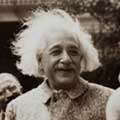 In
the year nineteen hundred, in the course of purely theoretical (mathematical)
investigation, Max Planck made a very remarkable discovery: the law of radiation
of bodies as a function of temperature could not be derived solely from
the Laws of Maxwellian electrodynamics. To arrive at results consistent
with the relevant experiments, radiation of a given frequency f had to be
treated as though it consisted of energy atoms (photons) of the individual
energy hf, where h is Planck's universal constant.
In
the year nineteen hundred, in the course of purely theoretical (mathematical)
investigation, Max Planck made a very remarkable discovery: the law of radiation
of bodies as a function of temperature could not be derived solely from
the Laws of Maxwellian electrodynamics. To arrive at results consistent
with the relevant experiments, radiation of a given frequency f had to be
treated as though it consisted of energy atoms (photons) of the individual
energy hf, where h is Planck's universal constant.
During the years following, it was shown that light was everywhere produced
and absorbed in such energy quanta. In particular, Niels Bohr was able to
largely understand the structure of the atom, on the assumption that the
atoms can only have discrete energy values, and that the discontinuous transitions
between them are connected with the emission or absorption of energy quantum.
This threw some light on the fact that in their gaseous state elements and
their compounds radiate and absorb only light of certain sharply defined
frequencies. (Albert Einstein, 1940)
Even the Greeks had already conceived the atomistic
nature of matter and the concept was raised to a high degree of probability
by the scientists of the nineteenth century. But it was Planck's law of
radiation that yielded the first exact determination - independent of other
assumptions - of the absolute magnitudes of atoms. More than that, he showed
convincingly that in addition to the atomistic structure of matter there
is a kind of atomistic structure to energy, governed by the universal constant
h, which was introduced by Planck.
This discovery became the basis of all twentieth-century research in physics
and has almost entirely conditioned its development ever since. Without
this discovery it would not have been possible to establish a workable theory
of molecules and atoms and the energy processes that govern their transformations.
Moreover, it has shattered the whole framework of classical mechanics and
electrodynamics and set science a fresh task: that of finding a
new conceptual basis for all physics. Despite remarkable partial
gains, the problem is still far from a satisfactory solution. (Albert
Einstein, 1950)
Albert Einstein (1905) used Planck's relationship to explain the results
of the photoelectric effect which showed that the energy E
of ejected electrons was dependent upon the frequency f
of incident light as described in the equation E=hf. It
is ironic that in 1921 Albert Einstein was awarded the Nobel Prize for this
discovery, though he never believed in particles and acknowledged that he
did not know the cause of the discrete energy transfers (photons) which
were contradictory to his continuous field theory of matter!
In 1954 Albert Einstein wrote to his friend Michael Besso expressing his
frustration;
All these fifty years of conscious brooding have brought me no nearer to the answer to the question, 'What are light quanta?' Nowadays every Tom, Dick and Harry thinks he knows it, but he is mistaken. (Albert Einstein, 1954)
Most importantly, Albert Einstein also suspected that Matter could not be described by a continuous spherical force field;
I consider it quite possible that physics cannot be based on the field concept, i.e., on continuous structures. In that case, nothing remains of my entire castle in the air, gravitation theory included, [and of] the rest of modern physics. (Albert Einstein, 1954)
Albert Einstein's suspicions were well justified, for he had spent a lifetime
trying (and failing) to create a unified field theory of matter that explained
both Quantum Theory / Light and Relativity / Gravity.
In fact Matter, as a Spherical Standing Wave which causes the 'Field' effect,
interacts with other matter in discrete standing wave patterns, not with
continuous force fields as he had imagined, thus his task was ultimately
impossible, as he sadly came to realise towards the end of his life.
However, his work on the photoelectric effect confirmed that light energy was only emitted and absorbed by electrons in discrete amounts or quanta. This quanta of light energy soon became known as the 'photon' (i.e. discrete like a particle) and led to the paradox that light behaved both as a continuous e-m wave (Maxwell, Albert Einstein) as well as a discrete particle/photon (Planck, Albert Einstein). So we see that Albert Einstein was partly responsible for the discovery of the particle (photon) concept of light, though he completely rejected the notion of discrete particles. He writes;
Since the theory of general relativity implies the representation of physical reality by a continuous field, the concept of particles or material points cannot play a fundamental part, nor can the concept of motion. (Albert Einstein)
Albert Einstein is correct that there are no discrete particles, and that
the particle can only appear as a limited region in space in which the field
strength or the energy density are particularly high. But it is the high
Wave-Amplitude of the Wave-Center of a Spherical Standing Wave in Space
(not of a continuous spherical force field) that causes the particle effect.
Thus of three concepts, particles, force fields,
and motion, it finally turns out that Motion, as the spherical
wave motion of space, is the correct concept, as it then explains both particles
and fields. (For further explanation see Article on Relativity)
It is most important to realise though that Albert Einstein was correct
in imagining matter as being spatially extended, as he explains;
I wished to show that space time is not necessarily something to which one can ascribe to a separate existence, independently of the actual objects of physical reality. Physical objects are not in space, but these objects are spatially extended. In this way the concept empty space loses its meaning. (Albert Einstein)
It is certainly true that the particle and its forces / fields are very
useful mathematical concepts, unfortunately, they also cause many problems
and paradoxes because they are approximations to reality and do not physically
exist. We can now finally solve these problems by understanding the reason
for these discrete energy states, which are due to the fact that standing
waves only exist at discrete frequencies, like notes on the string of a
guitar, thus while the Spherical Standing Wave Structure of Matter predicts
that energy exchanges will be discrete, as observed, the continuous e-m
wave does not anticipate this.
Thus the Spherical Standing Wave Structure of Matter explains Max Planck's
(1900) discovery that there are only certain allowed discrete energy states
for electrons in molecules and atoms, and further, that light is only ever
emitted and absorbed by electrons in discrete or 'quantum' amounts, as the
electrons move from one stable standing wave pattern to another.
Below are some further quotes from Albert Einstein on Quantum Theory. Please see main Albert Einstein Quantum Theory page for more details.
You believe in the God who plays dice, and I in complete law and order in a world which objectively exists, and which I, in a wildly speculative way, am trying to capture. I hope that someone will discover a more realistic way, or rather a more tangible basis than it has been my lot to find. Even the great initial success of the Quantum Theory does not make me believe in the fundamental dice-game, although I am well aware that our younger colleagues interpret this as a consequence of senility. No doubt the day will come when we will see whose instinctive attitude was the correct one. (Albert Einstein to Max Born, Sept 1944, 'The Born-Einstein Letters')
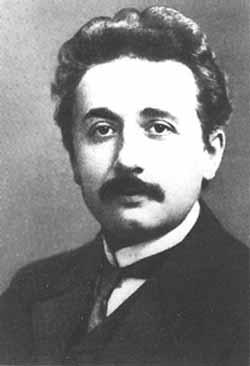 For
the time being we have to admit that we do not possess any general theoretical
basis for physics which can be regarded as its logical foundation. The field
theory, so far, has failed in the molecular sphere. It is agreed on all
hands that the only principle which could serve as a basis of quantum theory
would be one that constituted a translation of the field theory into the
scheme of quantum statistics. Whether this will actually come about in a
satisfactory manner, nobody can venture to say.
For
the time being we have to admit that we do not possess any general theoretical
basis for physics which can be regarded as its logical foundation. The field
theory, so far, has failed in the molecular sphere. It is agreed on all
hands that the only principle which could serve as a basis of quantum theory
would be one that constituted a translation of the field theory into the
scheme of quantum statistics. Whether this will actually come about in a
satisfactory manner, nobody can venture to say.
Some physicists, among them myself, cannot believe that we must abandon,
actually and forever, the idea of direct representation of physical reality
in space and time; or that we must accept the view that events in nature
are analogous to a game of chance . Probably never before has a theory been
evolved which has given a key to the interpretation and calculation of such
a heterogeneous group of phenomena of experience as has quantum theory.
In spite of this, however, I believe that the theory is apt to beguile us
into error in our search for a uniform basis for physics, because, in my
belief, it is an incomplete representation of real things, although it is
the only one which can be built out of the fundamental concepts of force
and material points (quantum corrections to classical mechanics). The incompleteness
of the representation leads necessarily to the statistical nature (incompleteness)
of the laws. (Albert Einstein, on Quantum Physics, 1954)
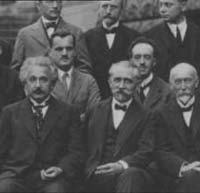 The next step was taken by de Broglie. He asked himself how the discrete
states could be understood by the aid of current concepts, and hit on a
parallel with stationary (standing) waves, as for instance in the case of
proper frequencies of organ pipes and strings in acoustics. (Albert Einstein,
on Quantum Theory, 1954)
The next step was taken by de Broglie. He asked himself how the discrete
states could be understood by the aid of current concepts, and hit on a
parallel with stationary (standing) waves, as for instance in the case of
proper frequencies of organ pipes and strings in acoustics. (Albert Einstein,
on Quantum Theory, 1954)
Experiments on interference made with particle rays have
given brilliant proof that the wave character of the phenomena of motion
as assumed by the theory does, really, correspond to the facts.
(Albert Einstein, on Quantum Theory, 1954)
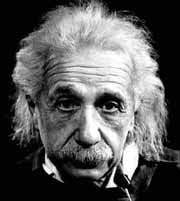 On
the basis of quantum theory there was obtained a surprisingly good representation
of an immense variety of facts which otherwise appeared entirely incomprehensible.
But on one point, curiously enough, there was failure: it proved impossible
to associate with these Schrodinger waves definite motions of the mass points
- and that, after all, had been the original purpose of the whole construction.
The difficulty appeared insurmountable until it was overcome by Born in
a way as simple as it was unexpected. The de Broglie-Schrodinger wave fields
were not to be interpreted as a mathematical description of how an event
actually takes place in time and space, though, of course, they have reference
to such an event. Rather they are a mathematical description of what we
can actually know about the system. They serve only to make statistical
statements and predictions of the results of all measurements which we can
carry out upon the system. (Quantum Mechanics, Albert Einstein, 1940)
On
the basis of quantum theory there was obtained a surprisingly good representation
of an immense variety of facts which otherwise appeared entirely incomprehensible.
But on one point, curiously enough, there was failure: it proved impossible
to associate with these Schrodinger waves definite motions of the mass points
- and that, after all, had been the original purpose of the whole construction.
The difficulty appeared insurmountable until it was overcome by Born in
a way as simple as it was unexpected. The de Broglie-Schrodinger wave fields
were not to be interpreted as a mathematical description of how an event
actually takes place in time and space, though, of course, they have reference
to such an event. Rather they are a mathematical description of what we
can actually know about the system. They serve only to make statistical
statements and predictions of the results of all measurements which we can
carry out upon the system. (Quantum Mechanics, Albert Einstein, 1940)
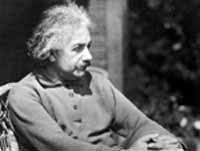 It seems to be clear, therefore, that Born's statistical interpretation
of quantum theory is the only possible one. The wave function does not in
any way describe a state which could be that of a single system; it relates
rather to many systems, to an 'ensemble of systems' in the sense of statistical
mechanics. (Albert Einstein, on Quantum Theory, 1936)
It seems to be clear, therefore, that Born's statistical interpretation
of quantum theory is the only possible one. The wave function does not in
any way describe a state which could be that of a single system; it relates
rather to many systems, to an 'ensemble of systems' in the sense of statistical
mechanics. (Albert Einstein, on Quantum Theory, 1936)
All attempts to represent the particle and wave features displayed in the phenomena of light and matter, by direct recourse to a space time model, have so far ended in failure. And Heisenberg has convincingly shown, from an empirical point of view, that any decision as to a rigorously deterministic structure of nature is definitely ruled out, because of the atomistic structure of our experimental apparatus. (Quantum Physics, Albert Einstein, 1954)
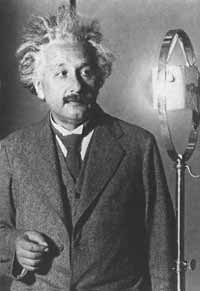 All these fifty years of conscious brooding have brought me no nearer to
the answer to the question, 'What are light quanta?' Nowadays
every Tom, Dick and Harry thinks he knows it, but he is mistaken. (Albert
Einstein, 'The Born-Einstein Letters' Max Born, translated by Irene
Born, Macmillan 1971)
All these fifty years of conscious brooding have brought me no nearer to
the answer to the question, 'What are light quanta?' Nowadays
every Tom, Dick and Harry thinks he knows it, but he is mistaken. (Albert
Einstein, 'The Born-Einstein Letters' Max Born, translated by Irene
Born, Macmillan 1971)
I still do not believe that the statistical method of the Quantum Theory is the last word, but for the time being I am alone in my opinion. (Albert Einstein, 1936, 'The Born-Einstein Letters' Max Born, translated by Irene Born, Macmillan 1971)
Quantum mechanics is certainly imposing. But an inner voice tells me that it is not yet the real thing. Quantum theory says a lot, but does not really bring us any closer to the secret of the Old One. I, at any rate, am convinced that He (God) does not throw dice. (Albert Einstein, On Quantum Physics, Letter to Max Born, December 12, 1926)
Einstein thinks he has a continuous field theory that avoids
'spooky action at a distance', but the calculation difficulties are very
great. He is quite convinced that some day a theory that does not depend
on probabilities will be found.
(Albert Einstein to Max Born, 1947, 'The Born-Einstein Letters' Max Born,
translated by Irene Born, Macmillan 1971)
I am well aware that no causality exists in relation to the observable; I consider this realisation to be conclusive. But in my opinion one should not conclude from this that the theory, too, has to be based on fundamental laws of statistics. It is, after all, possible that the (molecular) structure of the means of observation involves the statistical character of the observable, but that it is expedient in the end to keep the basis of the theory free from statistical concepts. (Albert Einstein to Max Born, 1948, 'The Born-Einstein Letters' Max Born, translated by Irene Born, Macmillan 1971)
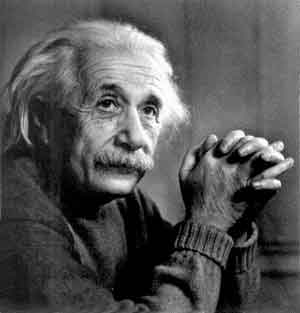 I
think that matter must have a separate reality independent of the measurements.
That is an electron has spin, location and so forth even when it is not
being measured. I like to think that the moon is there even if I am not
looking at it. (Albert Einstein)
I
think that matter must have a separate reality independent of the measurements.
That is an electron has spin, location and so forth even when it is not
being measured. I like to think that the moon is there even if I am not
looking at it. (Albert Einstein)
All my attempts to adapt the theoretical foundation of physics
to this new type of knowledge (Quantum Theory) failed completely. It was
as if the ground had been pulled out from under one, with no firm foundation
to be seen anywhere, upon which one could have built.
(P. A Schlipp, Albert Einstein: Philosopher – Scientist, On Quantum
Theory, 1949)
The quanta really are a hopeless mess.
(Albert Einstein, On doing Quantum Theory calculations with Pauli, 'The
Born-Einstein Letters' Max Born, translated by Irene Born, Macmillan 1971)
Help Humanity
"You must be the change you wish to see in the world."
(Mohandas Gandhi)
 "When forced to summarize the general theory of relativity in one sentence:
Time and space and gravitation have no separate existence from matter. ... Physical objects are not in space, but these objects are spatially extended. In this way the concept 'empty space' loses its meaning. ... The particle can only appear as a limited region in space in which
the field strength or the energy density are particularly high. ...
"When forced to summarize the general theory of relativity in one sentence:
Time and space and gravitation have no separate existence from matter. ... Physical objects are not in space, but these objects are spatially extended. In this way the concept 'empty space' loses its meaning. ... The particle can only appear as a limited region in space in which
the field strength or the energy density are particularly high. ...
The free, unhampered exchange of ideas and scientific conclusions is necessary for the sound development of science, as it is in all spheres
of cultural life. ... We must not conceal from ourselves that no improvement in the present depressing situation is possible without
a severe struggle; for the handful of those who are really determined to do something is minute in comparison with the mass of the lukewarm
and the misguided. ...
Humanity is going to need a substantially new way of thinking if it is to survive!" (Albert Einstein)
 We can now deduce the most simple science theory of reality - the wave structure of matter in space. By understanding how we and everything around us are interconnected
in Space we can then deduce solutions to the fundamental problems of human knowledge in physics, philosophy, metaphysics, theology, education, health, evolution and ecology, politics and society.
We can now deduce the most simple science theory of reality - the wave structure of matter in space. By understanding how we and everything around us are interconnected
in Space we can then deduce solutions to the fundamental problems of human knowledge in physics, philosophy, metaphysics, theology, education, health, evolution and ecology, politics and society.
This is the profound new way of thinking that Einstein
realised, that we exist as spatially extended structures of the universe - the discrete and separate body an illusion. This simply confirms the
intuitions of the ancient philosophers and mystics.
Given the current censorship in physics / philosophy of science journals (based on the standard model of particle physics / big bang cosmology) the internet is the best hope for getting new knowledge
known to the world. But that depends on you, the people who care about science and society, realise the importance of truth and reality.
It is Easy to Help!
Just click on the Social Network links at top of page, or copy a nice image or quote you like and share it. We have a wonderful collection of knowledge from the greatest minds in human history, so people will appreciate your contributions. In doing this you will help a new generation of scientists see that there is a simple sensible explanation of physical reality (One Substance, One Law) - the source of truth and wisdom, the only cure for the madness of man! Thanks! Geoff Haselhurst (Updated May, 2025)
A new scientific truth does not triumph by convincing its opponents and making them see the light, but rather because its opponents eventually die, and a new generation grows up that is familiar with it. (Max Planck, 1920)
"All that is necessary for evil to succeed is for good people to do nothing."
(Edmund Burke)
"In a time of universal deceit - telling the truth is a revolutionary act."
(George Orwell)
"Hell is Truth Seen Too Late."
(Thomas Hobbes)
Legal Disclaimer and Privacy Policy












